IPhone application localization: how to get 767% more downloads using keyword translation
All iOS developers dream of getting into the Top 10 App Store. Professional localization - the path to success. The problems that can be encountered on the way are the most diverse - localizability forgotten at the start of the project, poor translator, “curved” localization testing.
We hope the translation of this article will help assess the importance of localization, make it right and achieve the desired result. Reasonings, statistics and the small review of tools - under a cat.
Transferred to Alconost .
')

Many of you know that I’m just obsessed with the App Store optimization theme. Recently, I have been actively studying the principles of localization of applications (and, in particular, the localization of keywords). The idea of stable and shareware traffic is too attractive to blindly ignore, and that is why I am constantly working to improve my knowledge in this area.
Many of you may have heard about the theory of localization of applications for the iPhone. Distimo, one of the largest sources of information about applications and related statistics, published an article in October 2012 titled “The Importance of Application Translation” (the article is publicly available, you can download it here ). Their study found that after only one week after adding the translation of the iPhone application to the native for a particular country, the download language in it increases by an average of 128%, and income by 26%. Curiously, the same study showed almost zero effect for the iPad.
Analyzing the results of the Distimo study, it is important to note a very large sample size - 200 applications - thanks to which the data are very representative. The study, however, did not include the following: what is a translation at all? Simple localization of application content? Localization of the name of the application? What about keywords?
While the study leaves many unanswered questions, it definitely sheds light on potentially great opportunities in this area. Growth in the number of downloads by 120% and + 20% of income in each country? Why not!
So, armed with this data, I conducted my own small experiment on one of my applications. Of course, this was not happening in the laboratory, but I think that you will find my results quite interesting.
Below is a typical language distribution diagram for my non-localized application:

The data are given for the application “ Harlem Shake Yourself ”
As you can see, more than 76% of all traffic for this application comes from English-speaking countries (including British English). The next most common language is Spanish (8.9%), and the share of all other languages is insignificant.
The distribution of users by geography is clearly shown in the image below:
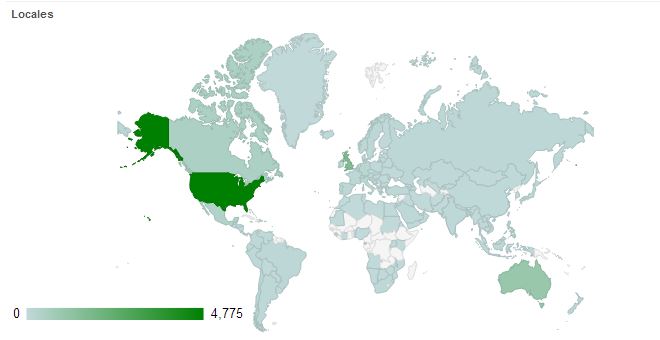
The United States in the image highlighted in bright color, and almost the rest of the world - in the fog.
And then I localized one of my applications. The contrast was simply astounding:
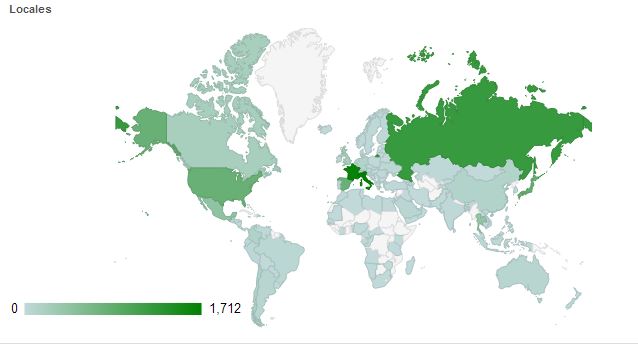
The data is given for the application “ Abe The Dragon ” after the localization of keywords
Suddenly, we see that now the whole world has played with new shades! In addition to the United States, we now have other key clusters of users, including France, Italy, Russia, Japan and China. Now we get traffic from all continents, not just from the USA.
So is it worth it? Still would! Here is a diagram showing the language distribution:
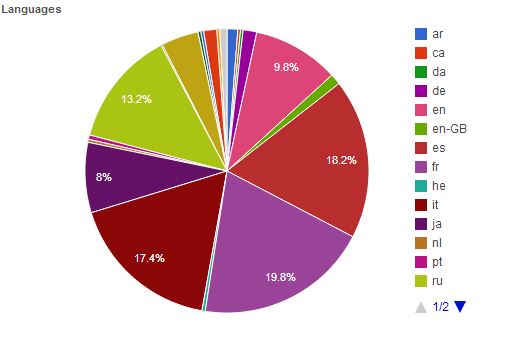
It is clearly seen that the share of applications with localized English keywords is (10%!) Of all downloads (compared to 76% earlier). This particular application had approximately 23,000 downloads per month - and, according to a 10% figure received earlier, only about 2,300 users were from English-speaking countries.
Simply put, without localization, we would have about 3000 downloads for that month. With localization, we got 23,000 downloads. Localization of keywords for this application has helped increase the number of downloads by 767%! Yes, it is more than 7 times more than what we could count on without it.
The results were simply amazing, so I continued to localize my other applications - and the result was the same over and over again.
So do you need localization? Yes of course! Without it, you miss a lot of potential traffic.
So how do you do this? When I talk about “localization”, in most cases it means localizing the application name and keywords — perhaps with a translation of the title in the description, in order to encourage users to download the application. Ideally, I would also localize all the screenshots, descriptions and texts in the applications. However, due to lack of time and resources, I decided to make changes only in those areas where these changes are most cost effective.
I am, of course, far from being the discoverer of this approach. Experienced marketers and developers, such as Trey Smith (Secret HQ Games) and Guy Schwartzman (now the founder and president of Revmob ), realized this a long time ago, and their applications very often find themselves in the top of the list for such popular search queries as “the best games” and “fun games”. However, judging by what I saw when performing large-scale research of keywords in other languages, there is still a great opportunity to really effectively use the localization capabilities of keywords, given the small number of developers who are engaged in this. It's time to wake up and understand that there is a big and hungry market outside the United States.
French, Spanish, Italian, and Russian worked very well . These four languages are worth all the others in terms of the amount of traffic I managed to get. Often, only one of them provided as much traffic as all English-speaking countries. This was because in English-speaking countries it is already very difficult to rely on popular keywords, and these markets still have great potential for optimization. I was especially surprised at how well the localization of Russian keywords worked.
Greek and Korean worked very badly . Perhaps this was due to the quality of my translation, or this situation reflects the total volume of traffic in these countries. As a result, I decided to postpone translation into these languages for a while.
Any keywords localized to Spanish will be indexed by the American App Store . I discovered this loophole completely by accident. It turns out that any keywords in the fields of the application name and its keywords that you use in Spanish localization (not to be confused with Mexican Spanish) will be automatically indexed by the American App Store (and only them). Obviously, this was done in the interests of the US Hispanic diaspora. A somewhat cynical way to use this loophole is to include here keywords that “do not fit” in the English localization.
Full matching keywords in the title are important . This thesis has been true for many years, and the importance of such keywords has increased and decreased after the updates of Google search algorithms. It seems that at present the presence of an exact match with the keyword in the name of the application significantly increases your chance to rise in the rating under certain conditions (depending on the competition for this word). This means that if you, for example, try to climb the keyword “racing games”, you must make sure that you have the words “racing” and “games” standing side by side in the same order, and there are no other intermediate words between them .
Despite the obviousness of the fact that the localization of keywords for the App Store dramatically increases downloads, I have not analyzed the data on income, which is somewhat more difficult to do, since income is obtained not only from purchases within applications (IAP), but also through advertising in various networks (where I don't have analytics by country). Ad networks usually pay the most in the US. But even without this analysis, I have no doubt that the localization of keywords will significantly raise the lower limit of your income.
If you generally know how to conduct keyword analysis, then selecting keywords in another language will not be difficult. For starters, you can read my extensive post about how to generally select keywords for applications .
A small warning: conducting keyword analysis (at least for me), especially in other languages, is a lot of work! I need an average of 2-3 hours per tongue. The basic set of languages that I strive to do for each application includes French, Italian, Spanish, Russian, German, Portuguese, Chinese (Simplified), and Japanese. It only takes me about 24 hours of working time to find keywords in these languages! I am now teaching my excellent assistant Maria to do this, and we hope that little by little she will take some of this load off of my shoulders (if someone has any suggestions on how to select keywords faster and more efficiently, I will be happy to talk!)
Great tool to get started. Due to time constraints, I usually don’t go too deeply into the analysis, but simply paste the translated keyword into the Keyword Planner; that is, in Spanish, I would enter the keyword “juegos” for games, and then explore the results. Make sure that the correct country is selected in the selection parameters, although I usually leave “all languages” because I want to see how people search in this country according to Google data.

Search results for “juegos”
Another good keyword research tool is Google Trends. If you optimize keywords for completely new thematic terms and phenomena, for example “gangnam style” or “harlem shake”, Keywords Planner may not be suitable due to insufficiently frequent updates of its base. In this case, Google Trends will be an excellent alternative, since you can enter your main keyword, select the country you need and see how often its residents search for this term.
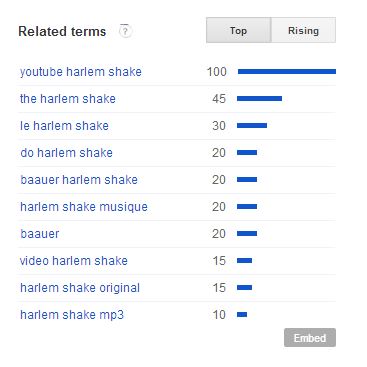
Google Trends search results for “Harlem Shake” in France
Probably one of the most important tools for selecting keywords. When you start typing a query in the App Store search window, you can see a lot of results offered by the system. For example, when I type “games” on my iPad, they offer me options such as “free games”, “games for girls”, “games for ipad” and so on. Although I have no clear evidence other than my own experience and conversations with other ASO experts, it’s obvious to me that these results are sorted according to the popularity of the search query. There is simply no better way to see what and how users search on the App Store. No matter how good the Google tools are, they do not completely reflect the structure of search queries in the App Store.
To use this tool to select an application keyword, open iTunes, select the country you want, and then type your keyword in the search box to display a list of related terms. Note: using iTunes is a compromise, as the results on mobile devices are different, but we hope that someone from the developers of tools for ASO will soon add this feature.
It is worth noting that some of the results were the names of the applications, some of them were the names of the performers, and the rest were actually user requests. I usually search for them.
To determine the most popular queries in different countries, I asked my assistant to run through the entire alphabet in each language and make a list of the most popular queries proposed by the search. The list of keywords is here (if you want to receive updated lists of keywords for all countries, leave a comment below or send me a tweet - if there is enough demand I will post updates regularly).
So, at the first stage, you had to find a list of keywords and terms that potential customers use to find the applications they need. Once you have done this, it remains to determine which of these words you intend to focus on. To do this, determine the popularity of the keyword, as well as the existing competition (do you have a chance to get to the top of the list?)
There are several ways that help me to draw conclusions about the popularity of a keyword.
Google Adwords Keyword Tool - monthly search volume . The number of queries on Google usually correlates well with the search volume in the App Store, but keep in mind that the results of these search engines are not identical to each other.
AppStoreRankings.net - ASR traffic rating . I have not fully decided how much attention this is worth, but ASR seems to be one of the best tools on the market. The data obtained with this tool is another indicator that I always take into account.
Evaluation of monthly downloads XYO Monthly . Xyo.net shows an approximate estimate of the number of monthly downloads for your applications, depending on the number of relevant requests. Accuracy is quite high, but, of course, does not reach 100%. The indications are representative only when you request the names of specific applications.
Top Charts ratings . If there are many applications in Top-Charts that contain a specific keyword, this can help to estimate the weight of an individual keyword. Fortunately, the ASR shows this data (but unfortunately, at present this only applies to ratings in the US).
The number of ratings . I think this is the most important information that I take into account. If the search for a particular word returns in the first lines of the application with a large number of ratings and reviews, there is no doubt that these programs download a lot.
The main tool I use to research the competition and popularity of a keyword is the above-mentioned ASR. This is the best tool for localizing application keywords, as it allows you to select a specific country for analysis.
The alternative to this is the use of iTunes, however this approach has three drawbacks. The first is that iTunes does not always show the same results that users get on their devices (ASR shows the results that are actually shown on the devices). Secondly, iTunes is very slow. Third, ASR gives you convenient statistics at once, including the exact number of competitors for the iPhone and for the iPad, as well as the level of difficulty of the keyword and traffic.

For example, if I enter the key phrase “meilleurs jeux”, “best games” in French (at least according to Google Translate), then ASR shows the following results:
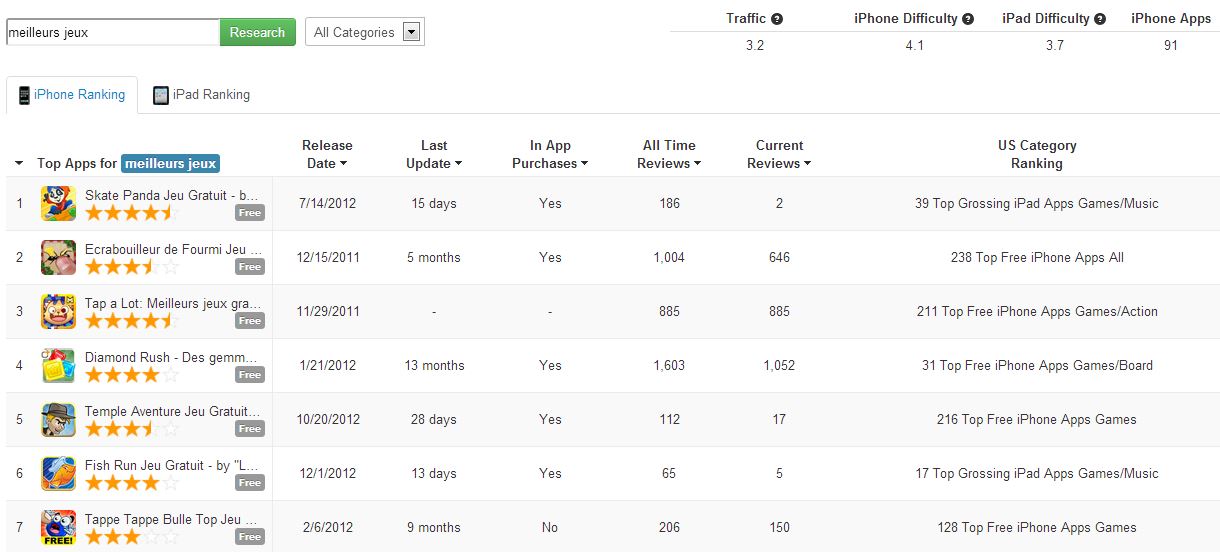
You can see how many competitors there are (91), how many reviews (for all time and for the current version), when the application was updated, whether the applications are free or paid, and also the US Category ratings. Almost all the necessary information right on the saucer!
There are a couple of nuances that I would like to note:
How many competitors do you have ? This is one of the most important moments. Choosing keywords, you should be absolutely, absolutely sure that you will take one of the first three places in the search results for the iPhone (for iPad, the situation is somewhat different - even a lower place guarantees a certain visibility in the search). Therefore, I mainly strive to use those keywords that have very few competitors, unless I have unique advantages, which are discussed below.
What are the exact or partial matches in the names of competitors ? As I have already noted, an exact match in the title can give you a significant advantage over competing applications. In the example above with “meilleurs jeux”: if other competitors do not have an exact match with this keyword in the title (and I have it), then I will have a really good chance to get to the top of the issue (or even to the 1st place) . On the other hand, if a large number of competitors do have exact or partial matches, then my chances of taking one of the first places will be insignificant.
What applications appear in search results - paid or free ? Paid applications are generally much harder to rank because the rating is based on the number of downloads. This means that if my application is free, and the main competitors are paid, I may have a chance to get around them.
As a result, you must create a large table for each language. Columns should be distributed as follows:
, . , !
:
.
: Google Translate, , , , , . -, , , , , , , , -10.
, , — , : https://alconost.com .
About the translator
The article is translated in Alconost.
Alconost is engaged in the localization of applications, games and websites in 60 languages. Language translators, linguistic testing, cloud platform with API, continuous localization, 24/7 project managers, any formats of string resources.
We also make advertising and training videos - for websites selling, image, advertising, training, teasers, expliners, trailers for Google Play and the App Store.
Read more: https://alconost.com
We hope the translation of this article will help assess the importance of localization, make it right and achieve the desired result. Reasonings, statistics and the small review of tools - under a cat.
Transferred to Alconost .
')

Many of you know that I’m just obsessed with the App Store optimization theme. Recently, I have been actively studying the principles of localization of applications (and, in particular, the localization of keywords). The idea of stable and shareware traffic is too attractive to blindly ignore, and that is why I am constantly working to improve my knowledge in this area.
Many of you may have heard about the theory of localization of applications for the iPhone. Distimo, one of the largest sources of information about applications and related statistics, published an article in October 2012 titled “The Importance of Application Translation” (the article is publicly available, you can download it here ). Their study found that after only one week after adding the translation of the iPhone application to the native for a particular country, the download language in it increases by an average of 128%, and income by 26%. Curiously, the same study showed almost zero effect for the iPad.
Analyzing the results of the Distimo study, it is important to note a very large sample size - 200 applications - thanks to which the data are very representative. The study, however, did not include the following: what is a translation at all? Simple localization of application content? Localization of the name of the application? What about keywords?
While the study leaves many unanswered questions, it definitely sheds light on potentially great opportunities in this area. Growth in the number of downloads by 120% and + 20% of income in each country? Why not!
So, armed with this data, I conducted my own small experiment on one of my applications. Of course, this was not happening in the laboratory, but I think that you will find my results quite interesting.
Experiment with application localization
Below is a typical language distribution diagram for my non-localized application:

The data are given for the application “ Harlem Shake Yourself ”
As you can see, more than 76% of all traffic for this application comes from English-speaking countries (including British English). The next most common language is Spanish (8.9%), and the share of all other languages is insignificant.
The distribution of users by geography is clearly shown in the image below:

The United States in the image highlighted in bright color, and almost the rest of the world - in the fog.
And then I localized one of my applications. The contrast was simply astounding:

The data is given for the application “ Abe The Dragon ” after the localization of keywords
Suddenly, we see that now the whole world has played with new shades! In addition to the United States, we now have other key clusters of users, including France, Italy, Russia, Japan and China. Now we get traffic from all continents, not just from the USA.
So is it worth it? Still would! Here is a diagram showing the language distribution:

It is clearly seen that the share of applications with localized English keywords is (10%!) Of all downloads (compared to 76% earlier). This particular application had approximately 23,000 downloads per month - and, according to a 10% figure received earlier, only about 2,300 users were from English-speaking countries.
Simply put, without localization, we would have about 3000 downloads for that month. With localization, we got 23,000 downloads. Localization of keywords for this application has helped increase the number of downloads by 767%! Yes, it is more than 7 times more than what we could count on without it.
The results were simply amazing, so I continued to localize my other applications - and the result was the same over and over again.
So do you need localization? Yes of course! Without it, you miss a lot of potential traffic.
A brief overview of the localization process
So how do you do this? When I talk about “localization”, in most cases it means localizing the application name and keywords — perhaps with a translation of the title in the description, in order to encourage users to download the application. Ideally, I would also localize all the screenshots, descriptions and texts in the applications. However, due to lack of time and resources, I decided to make changes only in those areas where these changes are most cost effective.
I am, of course, far from being the discoverer of this approach. Experienced marketers and developers, such as Trey Smith (Secret HQ Games) and Guy Schwartzman (now the founder and president of Revmob ), realized this a long time ago, and their applications very often find themselves in the top of the list for such popular search queries as “the best games” and “fun games”. However, judging by what I saw when performing large-scale research of keywords in other languages, there is still a great opportunity to really effectively use the localization capabilities of keywords, given the small number of developers who are engaged in this. It's time to wake up and understand that there is a big and hungry market outside the United States.
Experimental results
French, Spanish, Italian, and Russian worked very well . These four languages are worth all the others in terms of the amount of traffic I managed to get. Often, only one of them provided as much traffic as all English-speaking countries. This was because in English-speaking countries it is already very difficult to rely on popular keywords, and these markets still have great potential for optimization. I was especially surprised at how well the localization of Russian keywords worked.
Greek and Korean worked very badly . Perhaps this was due to the quality of my translation, or this situation reflects the total volume of traffic in these countries. As a result, I decided to postpone translation into these languages for a while.
Any keywords localized to Spanish will be indexed by the American App Store . I discovered this loophole completely by accident. It turns out that any keywords in the fields of the application name and its keywords that you use in Spanish localization (not to be confused with Mexican Spanish) will be automatically indexed by the American App Store (and only them). Obviously, this was done in the interests of the US Hispanic diaspora. A somewhat cynical way to use this loophole is to include here keywords that “do not fit” in the English localization.
Full matching keywords in the title are important . This thesis has been true for many years, and the importance of such keywords has increased and decreased after the updates of Google search algorithms. It seems that at present the presence of an exact match with the keyword in the name of the application significantly increases your chance to rise in the rating under certain conditions (depending on the competition for this word). This means that if you, for example, try to climb the keyword “racing games”, you must make sure that you have the words “racing” and “games” standing side by side in the same order, and there are no other intermediate words between them .
Warning
Despite the obviousness of the fact that the localization of keywords for the App Store dramatically increases downloads, I have not analyzed the data on income, which is somewhat more difficult to do, since income is obtained not only from purchases within applications (IAP), but also through advertising in various networks (where I don't have analytics by country). Ad networks usually pay the most in the US. But even without this analysis, I have no doubt that the localization of keywords will significantly raise the lower limit of your income.
Tools for finding popular keywords in other languages
If you generally know how to conduct keyword analysis, then selecting keywords in another language will not be difficult. For starters, you can read my extensive post about how to generally select keywords for applications .
A small warning: conducting keyword analysis (at least for me), especially in other languages, is a lot of work! I need an average of 2-3 hours per tongue. The basic set of languages that I strive to do for each application includes French, Italian, Spanish, Russian, German, Portuguese, Chinese (Simplified), and Japanese. It only takes me about 24 hours of working time to find keywords in these languages! I am now teaching my excellent assistant Maria to do this, and we hope that little by little she will take some of this load off of my shoulders (if someone has any suggestions on how to select keywords faster and more efficiently, I will be happy to talk!)
My favorite tools
Google Adwords Keyword Planner
Great tool to get started. Due to time constraints, I usually don’t go too deeply into the analysis, but simply paste the translated keyword into the Keyword Planner; that is, in Spanish, I would enter the keyword “juegos” for games, and then explore the results. Make sure that the correct country is selected in the selection parameters, although I usually leave “all languages” because I want to see how people search in this country according to Google data.

Search results for “juegos”
Google trends
Another good keyword research tool is Google Trends. If you optimize keywords for completely new thematic terms and phenomena, for example “gangnam style” or “harlem shake”, Keywords Planner may not be suitable due to insufficiently frequent updates of its base. In this case, Google Trends will be an excellent alternative, since you can enter your main keyword, select the country you need and see how often its residents search for this term.

Google Trends search results for “Harlem Shake” in France
App Store Search Suggest
Probably one of the most important tools for selecting keywords. When you start typing a query in the App Store search window, you can see a lot of results offered by the system. For example, when I type “games” on my iPad, they offer me options such as “free games”, “games for girls”, “games for ipad” and so on. Although I have no clear evidence other than my own experience and conversations with other ASO experts, it’s obvious to me that these results are sorted according to the popularity of the search query. There is simply no better way to see what and how users search on the App Store. No matter how good the Google tools are, they do not completely reflect the structure of search queries in the App Store.
To use this tool to select an application keyword, open iTunes, select the country you want, and then type your keyword in the search box to display a list of related terms. Note: using iTunes is a compromise, as the results on mobile devices are different, but we hope that someone from the developers of tools for ASO will soon add this feature.
It is worth noting that some of the results were the names of the applications, some of them were the names of the performers, and the rest were actually user requests. I usually search for them.
To determine the most popular queries in different countries, I asked my assistant to run through the entire alphabet in each language and make a list of the most popular queries proposed by the search. The list of keywords is here (if you want to receive updated lists of keywords for all countries, leave a comment below or send me a tweet - if there is enough demand I will post updates regularly).
Which keywords to bid on - keyword popularity
So, at the first stage, you had to find a list of keywords and terms that potential customers use to find the applications they need. Once you have done this, it remains to determine which of these words you intend to focus on. To do this, determine the popularity of the keyword, as well as the existing competition (do you have a chance to get to the top of the list?)
There are several ways that help me to draw conclusions about the popularity of a keyword.
Google Adwords Keyword Tool - monthly search volume . The number of queries on Google usually correlates well with the search volume in the App Store, but keep in mind that the results of these search engines are not identical to each other.
AppStoreRankings.net - ASR traffic rating . I have not fully decided how much attention this is worth, but ASR seems to be one of the best tools on the market. The data obtained with this tool is another indicator that I always take into account.
Evaluation of monthly downloads XYO Monthly . Xyo.net shows an approximate estimate of the number of monthly downloads for your applications, depending on the number of relevant requests. Accuracy is quite high, but, of course, does not reach 100%. The indications are representative only when you request the names of specific applications.
Top Charts ratings . If there are many applications in Top-Charts that contain a specific keyword, this can help to estimate the weight of an individual keyword. Fortunately, the ASR shows this data (but unfortunately, at present this only applies to ratings in the US).
The number of ratings . I think this is the most important information that I take into account. If the search for a particular word returns in the first lines of the application with a large number of ratings and reviews, there is no doubt that these programs download a lot.
What keywords to use - competition
The main tool I use to research the competition and popularity of a keyword is the above-mentioned ASR. This is the best tool for localizing application keywords, as it allows you to select a specific country for analysis.
The alternative to this is the use of iTunes, however this approach has three drawbacks. The first is that iTunes does not always show the same results that users get on their devices (ASR shows the results that are actually shown on the devices). Secondly, iTunes is very slow. Third, ASR gives you convenient statistics at once, including the exact number of competitors for the iPhone and for the iPad, as well as the level of difficulty of the keyword and traffic.

For example, if I enter the key phrase “meilleurs jeux”, “best games” in French (at least according to Google Translate), then ASR shows the following results:

You can see how many competitors there are (91), how many reviews (for all time and for the current version), when the application was updated, whether the applications are free or paid, and also the US Category ratings. Almost all the necessary information right on the saucer!
There are a couple of nuances that I would like to note:
How many competitors do you have ? This is one of the most important moments. Choosing keywords, you should be absolutely, absolutely sure that you will take one of the first three places in the search results for the iPhone (for iPad, the situation is somewhat different - even a lower place guarantees a certain visibility in the search). Therefore, I mainly strive to use those keywords that have very few competitors, unless I have unique advantages, which are discussed below.
What are the exact or partial matches in the names of competitors ? As I have already noted, an exact match in the title can give you a significant advantage over competing applications. In the example above with “meilleurs jeux”: if other competitors do not have an exact match with this keyword in the title (and I have it), then I will have a really good chance to get to the top of the issue (or even to the 1st place) . On the other hand, if a large number of competitors do have exact or partial matches, then my chances of taking one of the first places will be insignificant.
What applications appear in search results - paid or free ? Paid applications are generally much harder to rank because the rating is based on the number of downloads. This means that if my application is free, and the main competitors are paid, I may have a chance to get around them.
Conclusion
As a result, you must create a large table for each language. Columns should be distributed as follows:
- Keyword (in local language)
- Transfer
- Keyword Breakdown
- ASR
- XYO
- Google Keyword Planner
- : ?
, . , !
:
.
: Google Translate, , , , , . -, , , , , , , , -10.
, , — , : https://alconost.com .
About the translator
The article is translated in Alconost.
Alconost is engaged in the localization of applications, games and websites in 60 languages. Language translators, linguistic testing, cloud platform with API, continuous localization, 24/7 project managers, any formats of string resources.
We also make advertising and training videos - for websites selling, image, advertising, training, teasers, expliners, trailers for Google Play and the App Store.
Read more: https://alconost.com
Source: https://habr.com/ru/post/203070/
All Articles